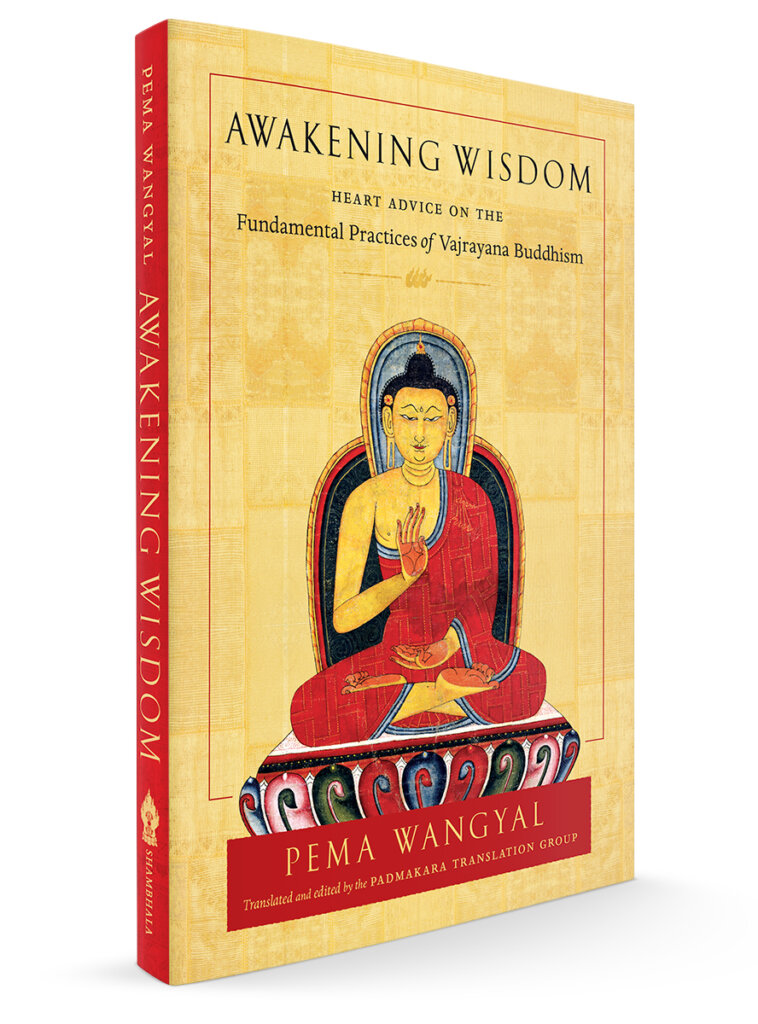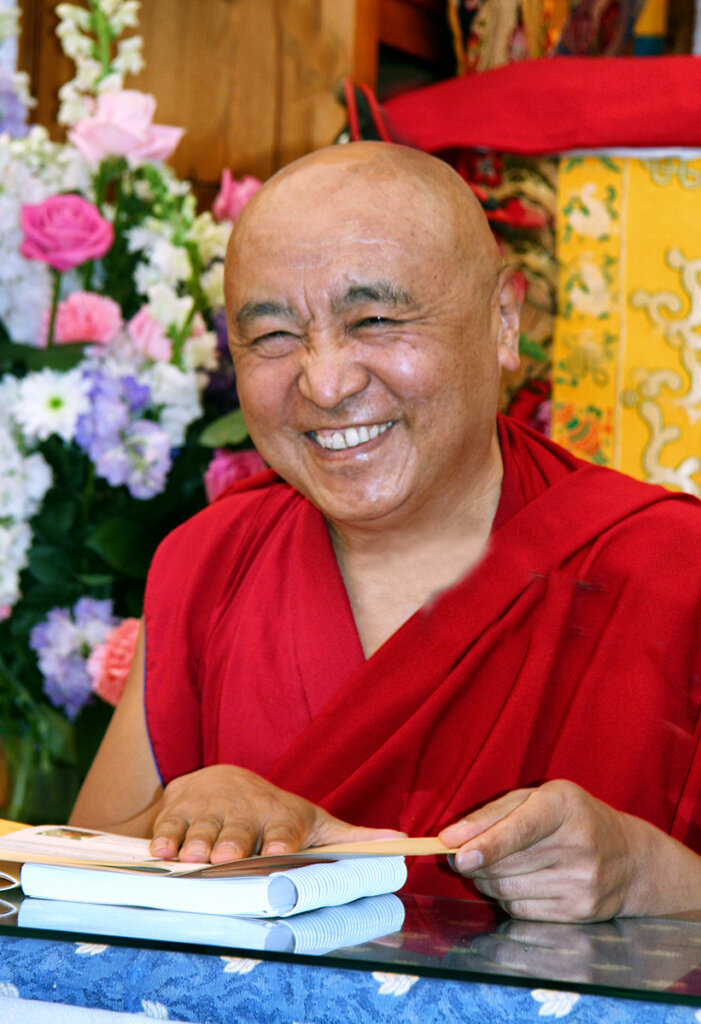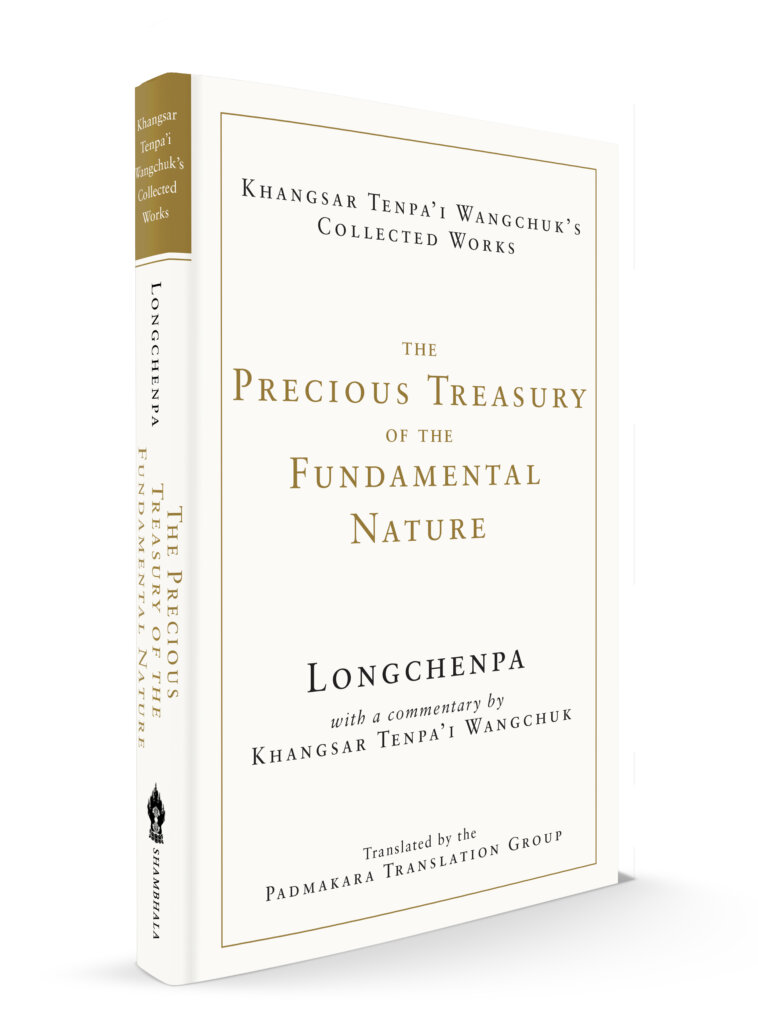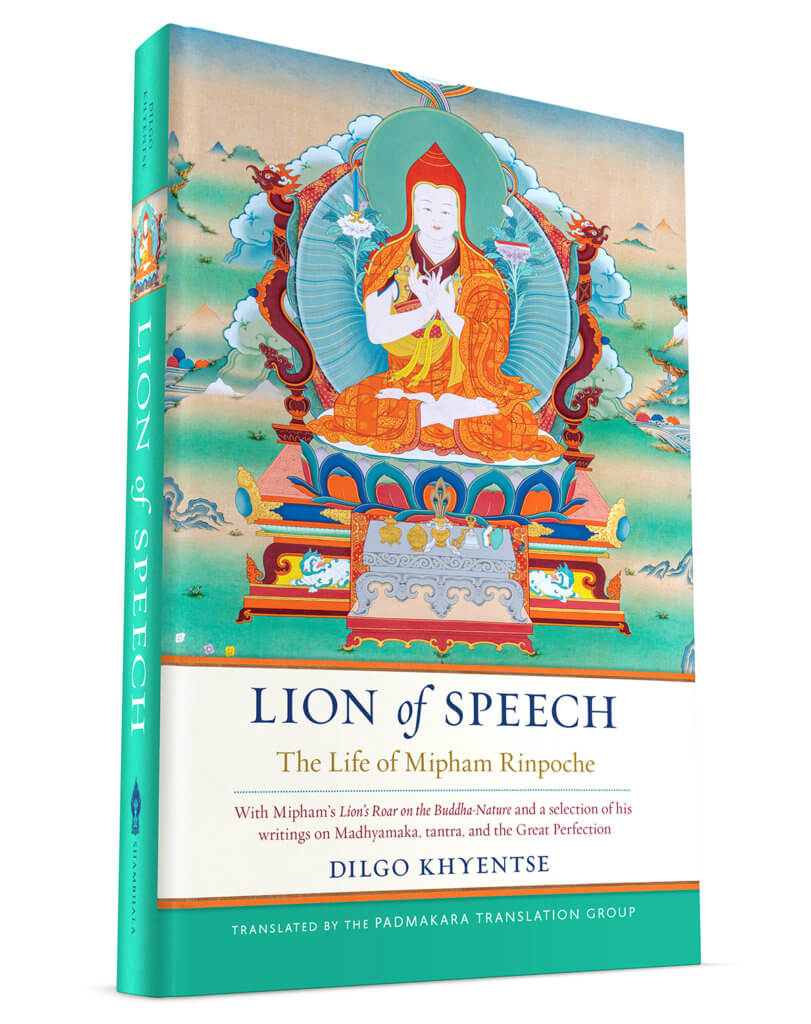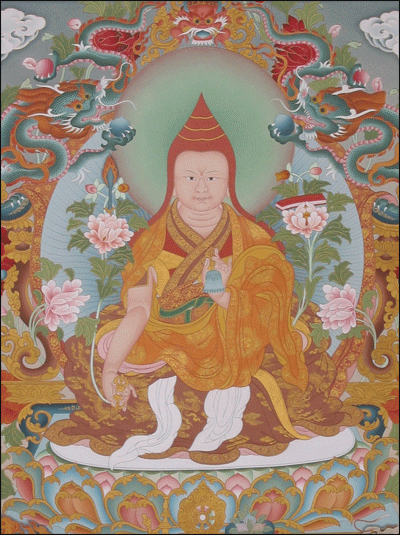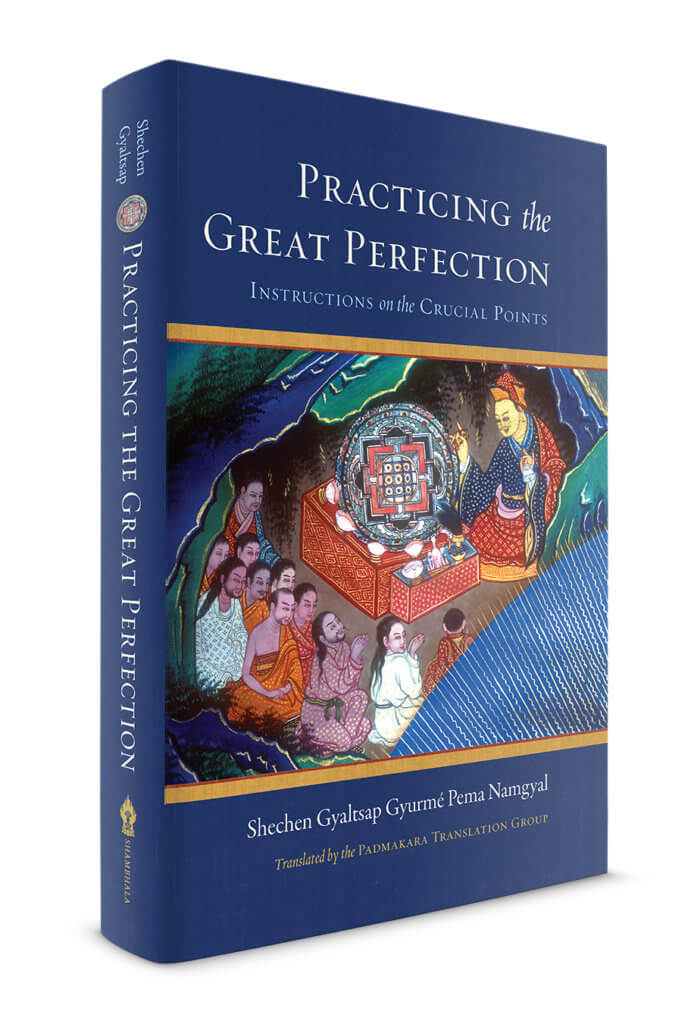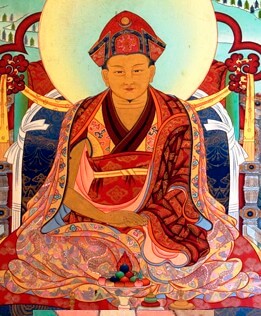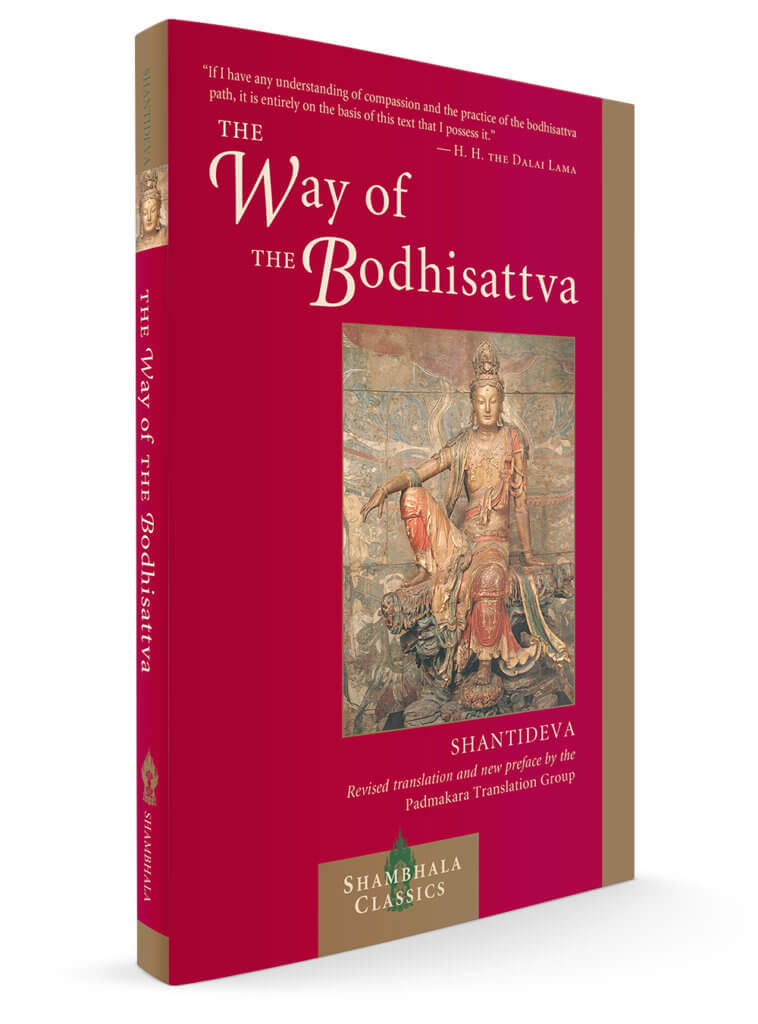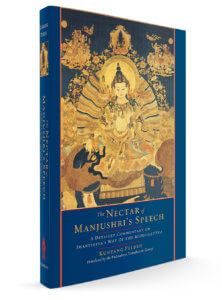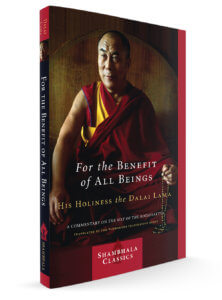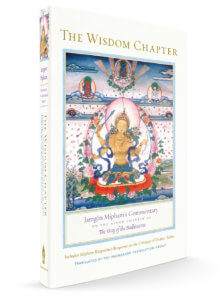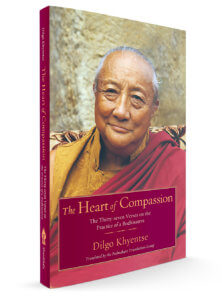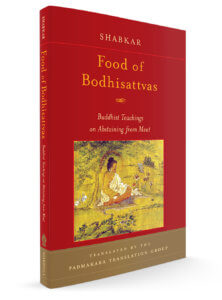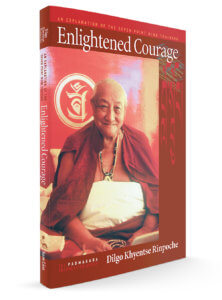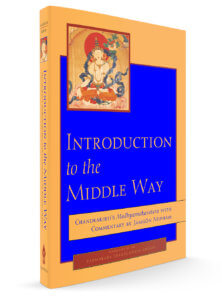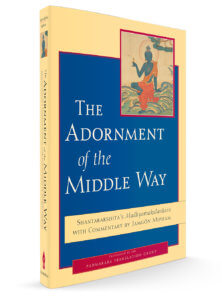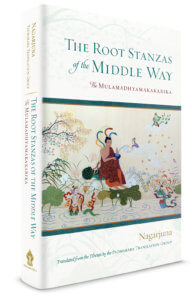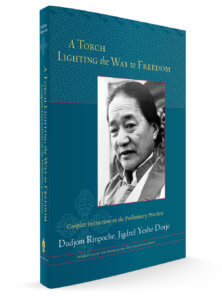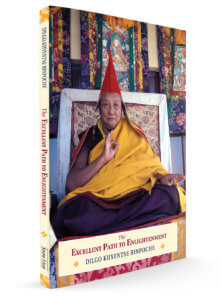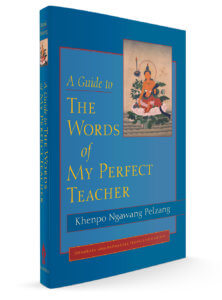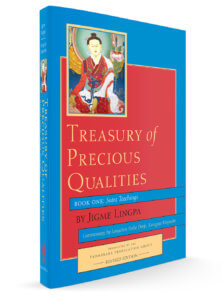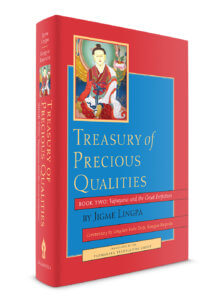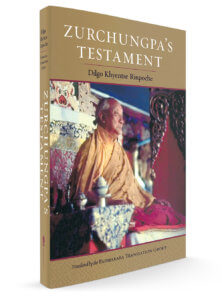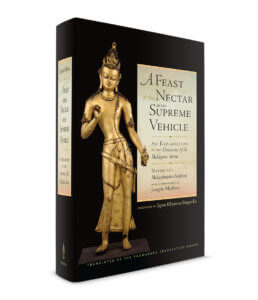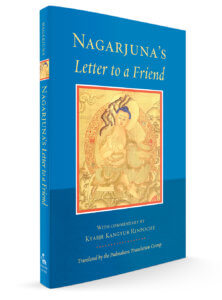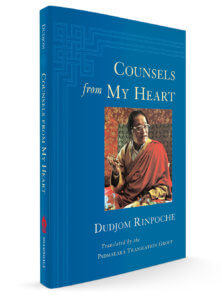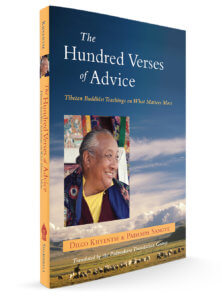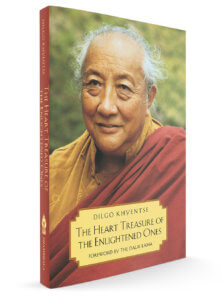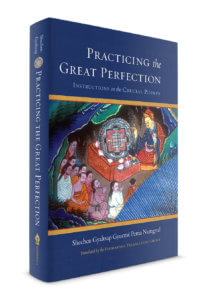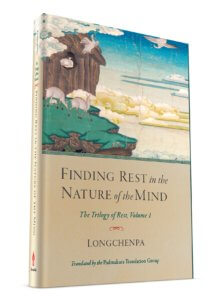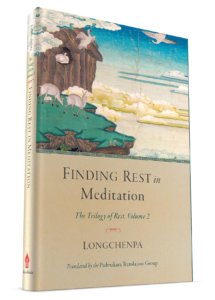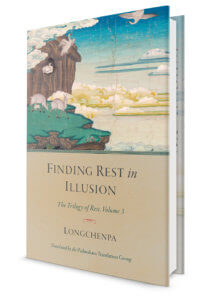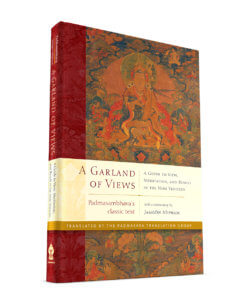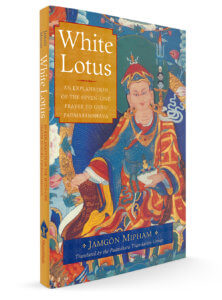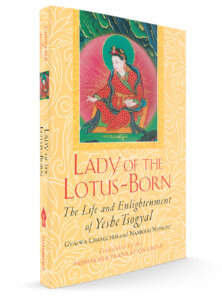
About the Padmakara Translation Group
The Padmakara Translation Group and its French language publishing branch Editions Padmakara were established in 1987 to preserve and make available for a Western readership the classics of Tibetan literature. Padmakara translators hail from all over world and work under the direction of Tsétrul Pema Wangyal Rinpoche and Jigmé Khyentse Rinpoche, two widely respected Tibetan Buddhist teachers.
Padmakara has translated dozens of works by the some of the greatest Buddhist masters, including Nagarjuna, Chandrakirti, Shantideva, Asanga, Maitreya, Shantarakshita, Padmasambhava, Yeshe Tsogyal, Zurchungpa, Longchenpa, Jigme Lingpa, Mipham Rinpoche, Shechen Gyaltsap, Shabkar, Dilgo Khyentse Rinpoche, Khenpo Kunpel, Khenpo Ngawang Pelzang, Dilgo Khyentse, Dudjom Rinpoche, and the Dalai Lama.
Shambhala Publications is proud to publish the unparalleled work of the Padmakara Translation Group. The principal translators for our most recent Padmakara titles are Wulstan Fletcher, Helena Blankleder, and Stephen Gethin. Other members of the group who have contributed one or more works include John Canti, Matthieu Ricard, and Charles Hastings.
Jump To: New | Ngöndro | Bodhisattva Path | Madhyamaka | Essential Teachings | Vajrayana & Dzogchen
Latest Releases
Awakening Wisdom: Heart Advice on the Fundamental Practices of Vajrayana Buddhism
by Tulku Pema Wangyal Rinpoche , translated by the Padmakara Translation Group
If you are new to Tibetan Buddhism, this short work will help you get started with your practice; and if you are well steeped in these teachings, it will inspire and motivate you to practice them. Originally delivered in the form of advice to retreatants, Pema Wangyal’s teachings cover developing a proper motivation, settling the mind, mantra recitation, and relating to the suffering of others. In the last part of the book, he provides guidance about the preliminary practices in the Dudjom Rinpoche lineage. Pema Wangyal’s writing is suffused with warmth and tenderness throughout, making this book quite accessible and inviting to everyone.
Padmakara's Wulstan Fletcher on the Translation Group's Approach to Translation
A lightly edited except on the English translation of "compassion":
"'Compassion' will work up to a point depending on the text we are translating. But compassion and nyingje are not really equivalents at all. 'Compassion' means the ability to suffer with somebody. Whereas the "je" part of nyingje has this connotation of a heroic intolerance of the suffering of others and the decision to put an end to it. And that's ok for a large portion of texts, but when you get into Dzogchen, you find ngowo rangzin thukje (the honorific of nyingje). The Tibetan word is exactly the same, but translating it as 'compassion' does not work at all, in any sense of the word. Because originally thukje or nyingje had this feeling of "the lord of the heart' or 'lord of the mind' or the 'supreme element of the mind' which it has right through the different levels of teaching. But when it comes to "ngowo tongpa rangzhin selwa thukje mengagpa, or "untrammeled compassion", it means rigpa selwa, the creative expression of the nature of the mind.
Modern scholar and Nyingma master Khangsar Tenpa’i Wangchuk composed this first and only commentary on the fourteenth-century Buddhist master Longchenpa’s essential text, The Precious Treasury of the Fundamental Nature. The root text establishes the definitive view of the secret class of pith instructions of Dzogchen, the Great Perfection. Tenpa’i Wangchuk’s word-commentary elucidates the nature of phenomena adhering closely to the internal structure of Longchenpa’s verses, clearly presenting the four vajra principles of the nature of phenomena: nonexistence, evenness, spontaneous presence, and single nature.
The commentary by Khangsar Tenpa’i Wangchuk is here translated for the first time, commencing an extended project to render his entire collected works in English. This is an invaluable resource for students of Buddhism who wish to deepen their understanding of the nature of mind and phenomena as presented in the Great Perfection tradition.
Lion of Speech
The Life of Mipham Rinpoche
by Dilgo Khyentse Rinpoche
An unearthed masterpiece on Mipham Rinpoche—one of the greatest 19th-century masters.
The first half of this volume comprises the first-ever English translation of the biography of Mipham Rinpoche written by Dilgo Khyentse Rinpoche. Reverential in tone, it is informed by both oral accounts preserved in notes kept by Khyentse Rinpoche’s elder brother and the recollections of Mipham’s devoted personal attendant of thirty-seven years.
The second half comprises a selection of Mipham’s writings, designed to give the reader an experience of Mipham’s eloquent speech and incisive thought. It includes both a new translation of The Lion’s Roar: A Comprehensive Discourse on the Buddha-Nature and A Lamp to Dispel the Dark, a teaching of the Great Perfection, as well as excerpts from previously published translations of his works on Madhyamaka and tantra.
Practicing the Great Perfection
Instructions on the Crucial Points
by Shechen Gyaltsap Gyurme Pema Namgyal
A set of essential works on Dzogchen by Shechen Gyaltsap, the root teacher of Dilgo Khyentse. Included here are essential instructions for those who practice, or aspire to practice, the teachings of the Great Perfection. Written with a clear simplicity that belies their profundity, these teachings give practical and pointed advice on how to meditate on the nature of mind, self-arisen primordial wisdom, and how to sustain this practice in daily life. They begin with an extensive reflection on the problem of self-clinging and the analytical meditation designed to uproot it, and proceed to more specific instructions for the mind practice itself, at all times insisting on the fundamental, indispensable attitudes of renunciation and bodhichitta—the determination to awaken for the benefit of all beings.
On the Bodhisattva Path
The Way of the Bodhisattva
by Shantideva
Treasured by Buddhists across traditions, Shantideva’s Way of the Bodhisattva is a guide for anyone seeking to cultivate the mind of enlightenment and the qualities of love, compassion, patience, and generosity. Presented in the form of a personal meditation in verse, it outlines the path of the Bodhisattvas—those who renounce the peace of individual enlightenment, and vow to work for the liberation of all beings and to attain Buddhahood for their sake.
The Nectar of Manjushri's Speech
A Detailed Commentary on Shantideva's Way of the Bodhisattva
by Khenpo Kunzang Pelden
The Bodhicharyavatara, or Way of the Bodhisattva, composed by the eighth-century Indian master Shantideva, has occupied an important place in the Tibetan Buddhist tradition throughout its history. It is a guide to cultivating the mind of enlightenment through generating the qualities of love, compassion, generosity, and patience. In this commentary, Kunzang Pelden has compiled the pith instructions of his teacher Patrul Rinpoche, the celebrated author of The Words of My Perfect Teacher.
For the Benefit of Beings
A Commentary on The Way of the Bodhisattva
by His Holiness the Fourteenth Dalai Lama
In this commentary on key sections of the text, the Dalai Lama shows how any of us can develop a truly “good heart,” and why aspiring toward the happiness and enlightenment of others is central to any genuinely spiritual path. His Holiness’s profound wisdom—the result of a lifetime of practice and study—shines brilliantly throughout this extraordinary book.
The Wisdom Chapter
Jamgön Mipham’s Commentary on the Ninth Chapter of The Way of the Bodhisattva
by Jamgön Mipham
This commentary by the great scholar Mipham Rinpoche presents in quite straightforward terms Shāntideva’s exposition of emptiness, the essential foundation of all Buddhist doctrine, demonstrating that it is not only compatible with, but in fact crucial to, the correct understanding of other important Buddhist teachings such as karma, rebirth, and the practice of compassion. Mipham interprets Shāntideva according to the view of the Nyingma school, which in some respects was at variance with the religiously and politically dominant interpretation of the text in Tibet at that time. As a result, his commentary stirred up a furious debate. With the addition of a critique of Mipham Rinpoche’s view by a prominent scholar of the time, along with Mipham’s response, that debate is beautifully captured in this volume.
The Heart of Compassion
The Thirty-seven Verses on the Practice of a Bodhisattva
by Dilgo Khyentse Rinpoche
A training manual composed in the fourteenth century by the Buddhist hermit Ngulchu Thogme, here explained in detail by one of the great Tibetan Buddhist masters of the twentieth century, Dilgo Khyentse. In the Mahayana tradition, those who have the courage to undertake the profound change of attitude required to develop true compassion are called bodhisattvas. Their great resolve—to consider others’ needs as paramount, and thus to attain enlightenment for the sake of all living creatures—carries them beyond the limits imposed by the illusions of “I” and “mine,” culminating in the direct realization of reality, transcending dualistic notions of self and other. This classic text presents ways that we can work with our own hearts and minds, starting wherever we find ourselves now, to unravel our small-minded preoccupations and discover our own potential for compassion, love, and wisdom.
Food of the Bodhisattvas
Buddhist Teachings on Abstaining from Meat
by by Shabkar Tsogdruk Rangdrol
This book offers the most compelling and impassioned indictment of meat-eating to be found in Tibetan literature and is pertinent to anyone interested in vegetarianism as a moral or spiritual issue. The Buddha's teachings show how destructive habits can be examined and transformed gradually from within. The aim is not to repress one's desire for meat and animal products by force of will, but to develop heartfelt compassion and sensitivity to the suffering of animals, so that the desire to exploit and feed on them naturally dissolves.
There are two texts presented here. One is an excerpt from Shabkar's Book of Marvels, consisting of quotations from the Buddhist scriptures and the teachings of masters of Tibetan Buddhism that argue against the consumption of meat, with Shabkar's commentary. The second, the Nectar of Immortality , is Shabkar's discourse on the importance of developing compassion for animals.
Enlightened Courage
An Explanation of the Seven-Point Mind Training
by Dilgo Khyentse Rinpoche
Condensing the compassionate path to Buddhahood into practical instructions that use the circumstances of everyday life, Rinpoche presents the Seven-Point Mind Training—the very core of the entire Tibetan Buddhist practice.
Madhyamaka
Introduction to the Middle Way
Chandrakirti's Madhyamakavatara with Commentary by Ju Mipham
by Chandrakirti and Ju Mipham
This book is one of the most useful ways to understand the view of Madhyamaka. This work includes a verse translation of the Madhyamakavatara by the renowned seventh-century Indian master Chandrakirti, an extremely influential text of Mahayana Buddhism, followed by an exhaustive logical explanation of its meaning by the modern Tibetan master Jamgön Mipham, composed approximately twelve centuries later. Chandrakirti's work is an introduction to the Madhyamika teachings of Nagarjuna, which are themselves a systematization of the Prajnaparamita, or "Perfection of Wisdom" literature, the sutras on the crucial but elusive concept of emptiness.
The Adornment of the Middle Way
Shantarakshita's Madhyamakalankara with Commentary by Jamgon Mipham
by Shantarakshita and Jamgön Mipham
In the Madhyamakalankara, Shantarakshita synthesized the views of Madhyamaka and Yogachara, the two great streams of Mahayana Buddhism. This was the last great philosophical development of Buddhist India.
In his brilliant and searching commentary, Mipham re-presented Shantarakshita to a world that had largely forgotten him, defending his position and showing how it should be understood in relation to the teaching of Chandrakirti. To do this, he subtly reassessed the Svatantrika-Prasangika distinction, thereby clarifying and rehabilitating Yogachara-Madhyamaka as a bridge whereby the highest philosophical view on the sutra level flows naturally into the view of tantra. Mipham’s commentary has with reason been described as one of the most profound examinations of Madhyamaka ever written.
This volume presents a new English translation of the founding text of the Madhyamaka (Middle Way) school of Mahayana Buddhism, Nagarjuna’s Root Stanzas of the Middle Way, and includes the Tibetan version of the text. The Root Stanzas holds an honored place in all branches of Tibetan Buddhism, as well as in the Buddhist traditions found in China, Japan, and Korea, because of the way it develops the seminal view of emptiness (shunyata), which is crucial to understanding Mahayana Buddhism and central to its practice. It is prized for its pithy and pointed arguments that show that things lack intrinsic being and thus are “empty” (shunya). They abide in the Middle Way, free from the extremes of permanence and annihilation.
The Wisdom Chapter
Jamgön Mipham’s Commentary on the Ninth Chapter of The Way of the Bodhisattva
by Jamgön Mipham
This commentary by the great scholar Mipham Rinpoche presents in quite straightforward terms Shāntideva’s exposition of emptiness, the essential foundation of all Buddhist doctrine, demonstrating that it is not only compatible with, but in fact crucial to, the correct understanding of other important Buddhist teachings such as karma, rebirth, and the practice of compassion. Mipham interprets Shāntideva according to the view of the Nyingma school, which in some respects was at variance with the religiously and politically dominant interpretation of the text in Tibet at that time. As a result, his commentary stirred up a furious debate. With the addition of a critique of Mipham Rinpoche’s view by a prominent scholar of the time, along with Mipham’s response, that debate is beautifully captured in this volume.
Ngöndro: The Preliminary or Foundational Practices
The vow to perfect oneself in order to perfect others is called the thought of enlightenment, or bodhichitta. This implies that every single action word or thought even the most trivial is dedicated to the good of all beings. To accomplish the good of others, we must first perfect ourselves by purifying and transforming our minds. This is the aim of what we call the preliminary practices, or ngöndro, which establish the foundation of all spiritual progress.
A Torch Lighting the Way to Freedom
Complete Instructions on the Preliminary Practices
by Kyabje Dudjom Rinpoche
The foundations of Vajrayana practice are laid out with eloquence and precision here by one of the greatest Tibetan Buddhist masters of our age. His Holiness Dudjom Rinpoche’s commentary on the preliminary practices (ngöndro) is informed by his profound realization and wide-ranging scholarship, and illuminated with an array of quotations from the Vinaya, Sutra, and Tantra traditions. In addition to the commentary on the outer and inner preliminary practices, he provides other invaluable instructions on the correct view, conduct, and activity of a practitioner. Dudjom Rinpoche taught that the realization of the teachings of the Great Perfection depends entirely on these preliminary practices, thus his compassionate exposition of them here makes this book a particularly precious resource for anyone who seeks to remove the obstacles between themselves and the total freedom of enlightenment.
A Look at Two Ngöndro Texts
Padmakara Translation Group member Stephen Gethin highlights the differences and complimentary aspects of Patrul Rinpoche's Words of My Perfect Teacher and Dudjom Rinpoche's A Torch Lighting the Way to Freedom, both of which Padmakara translated.
The Excellent Path to Enlightenment
Oral Teachings on the Root Text of Jamyang Khyentse Wangpo
by Jamyang Khyentse Wangpo and Dilgo Khyentse
In this book, Dilgo Khyentse Rinpoche explains a key practice text composed by Jamyang Khyentse Wangpo (1820–1892) on the Vajrayana preliminaries: taking refuge, generating the thought of achieving enlightenment for the sake of all beings, performing the meditation, and recitation of Vajrasattva to remove hindrances on the path to enlightenment, offering the mandala to accumulate merit and wisdom, and developing proper reliance on a spiritual teacher. Clear, direct, and personal, these instructions illuminate the heart of Vajrayana practice. Included here are the Tibetan text as well as the mantras and prayers commonly recited in conjunction with this practice.
A Guide to The Words of My Perfect Teacher
by Khenpo Ngawang Pelzang
This guide provides readers with essential background information for studying and practicing with Patrul Rinpoche's Words of My Perfect Teacher—the text that has, for more than a century, served as the reliable sourceBook to the spiritual practices common to all the major schools of Tibetan Buddhism. By offering chapter-by-chapter commentary on this renowned work, Khenpo Pelzang provides a fresh perspective on the role of the teacher; the stages of the path; the view of the Three Jewels; Madhyamika, the basis of transcendent wisdom; and much more.
Essential Teachings from the Tibetan and Indian Traditions
Treasury of Precious Qualities: Book One
Volume 1, Sutra Teachings
by Jigme Lingpa and Kangyur Rinpoche
The Treasury of Precious Qualities is one of the most important works in the Nyingma tradition, studied by all. The present volume lays out the teachings of the sutras in gradual stages according to the traditional three levels, or scopes, of spiritual endeavor. It begins with essential teachings on impermanence, karma, and ethics. Then, from the Hinayana standpoint, it describes the essential Buddhist teachings of the four noble truths and the twelve links of dependent arising. Moving on, finally, to the Mahayana perspective, it expounds fully the teachings on bodhichitta and the path of the six paramitas, and gives an unusually detailed exposition of Buddhist vows.
Treasury of Precious Qualities: Book Two
Vajrayana and the Great Perfection
by Jigme Lingpa and Kangyur Rinpoche
This book is a translation of the second part of a commentary on the Treasury of Precious Qualities, the most celebrated work of Jigme Lingpa (1730–1798), one of the most important figures in the Nyingma lineage. In a slender volume of elegant verses this root text presents the entire Buddhist path according to the Nyingma school. Because it is so concise and makes use of elaborate, poetic language, the commentary is indispensable.
Zurchungpa's Testament
by Zurchung Sherab Drakpa and Dilgo Khyentse Rinpoche
Now in Paperback. Zurchung Sherab Drakpa, the 11th century Nyingma master of the Zur clan, was an early pillar of the Tibetan Buddhist tradition. His Eighty Chapters of Personal Advice is the distillation of a lifetime’s experience and practical instructions from a master who truly embodied the teachings of the Great Perfection. Organized into eighty chapters covering the entire path of Dzogchen, this book contains a complete detailed teaching on Zurchungpa’s text by Dilgo Khyentse Rinpoche, based on Shechen Gyaltsap’s notes.
A Feast of the Nectar of the Supreme Vehicle
An Explanation of the Ornament of the Mahayana Sutras
by Maitreya, Asanga, and Jamgön Mipham
A monumental work and Indian Buddhist classic, the Ornament of the Mahāyāna Sūtras (Mahāyānasūtrālamkāra) is a precious resource for students wishing to study in-depth the philosophy and path of Mahāyāna Buddhism. This full translation and commentary outlines the importance of Mahāyāna, the centrality of bodhicitta or the mind of awakening, the path of becoming a bodhisattva, and how one can save beings from suffering through skillful means.
This definitive composition of Mahāyāna teachings was imparted in the fourth century by Maitreya to the famous adept Asanga, one of the most prolific writers of Buddhist treatises in history. Asanga’s work, which is among the famous Five Treatises of Maitreya, has been studied, commented upon, and taught by Buddhists throughout Asia ever since it was composed.
In the early twentieth century, one of Tibet’s greatest scholars and saints, Jamgön Mipham, wrote A Feast of the Nectar of the Supreme Vehicle, which is a detailed explanation of every verse. This commentary has since been used as the primary blueprint for Tibetan Buddhists to illuminate the depth and brilliance of Maitreya’s pith teachings. The Padmakara Translation Group has provided yet another accessible and eloquent translation, ensuring that English-speaking students of Mahāyāna will be able to study this foundational Buddhist text for generations to come.
The great Indian Buddhist master Nagarjuna wrote his celebrated poem Letter to a Friend as a gift of advice to a South Indian king, and it has since become a monument in the Indian shastra tradition. Despite its short length (only 123 verses), it covers the entire Mahayana path, combining a practical approach to daily conduct with a theoretical exposition of the different stages leading to enlightenment. It has thus been an ideal source for many of Tibet’s greatest scholars seeking a scriptural authority to enhance their own descriptions of the Buddhist path.
In addition to a new English translation of the poem presented alongside the original Tibetan, this book includes commentary and a structural outline by the great twentieth-century scholar Kyabje Kangyur Rinpoche.
Counsels from My Heart
by Kyabje Dudjom Rinpoche
A small books with great impact. In these teachings, Dudjom Rinpoche calls upon us to follow the Buddha’s instructions to “get a grip on our minds.” He points the way to giving up our habitual ways of behaving in order to liberate ourselves from suffering. He also offers advice on how to view the Vajrayana teachings—which are said to be so powerful that they can be dangerous if misunderstood or practiced incorrectly. He says the most important point is to study the view of the Great Perfection, which is, essentially, that all phenomena are empty by nature. But this mustn’t cause us to fall into the trap of acting on our own meager understanding. He says: “Like eagles soaring in space, we should be clearly convinced of the view, but at the same time we should heed the karmic principle of cause and effect.”

Audiobook read by actor Simon Callow
The Hundred Verses of Advice
Tibetan Buddhist Teachings on What Matters Most
by Padampa Sangye and Dilgo Khyentse Rinpoche
This commentary on Padampa Sangye's classic verses of advise to Tibetan villagers of Tingri—by renowned and beloved meditation master Dilgo Khyentse—offers guidance for people trying to lead a dharmic life in the workaday world. These hundred verses, studied for centuries by Tibetans and students of Buddhism, contain a complete survey of the Tibetan Buddhist path. Dilgo Khyentse's lively explication of each stanza brings to light subtleties and amplifies the richness of the words and their pertinence to our lives. These two venerable teachers advise us in relating to everyday difficulties such as loneliness, craving, family squabbles, competition in business, disagreements with neighbors, and betrayal by friends—as challenging to us as they have been to meditators for centuries.
Heart Treasure of the Enlightened Ones
The Practice of View, Meditation, and Action
by Patrul Rinpoche and Dilgo Khyentse Rinpoche
In this book, two great Tibetan Buddhist masters of the nineteenth and twentieth centuries challenge us to critically examine our materialistic preoccupations and think carefully about how we want to spend the rest of our lives. At the same time, they provide practical guidance in following the Buddhist path, starting from the most basic motivation and culminating in the direct experience of reality beyond the reach of conceptual mind.
The root text is a teaching in verse written in the nineteenth century by Patrul Rinpoche, one of the outstanding teachers of his day. In the accompanying commentary, Dilgo Khyentse Rinpoche (1910–1991)—lineage holder of the Nyingma school and one of the great expounders of the Dharma in Europe and North America—expands upon the text with his characteristic compassion and uncompromising thoroughness. Patrul Rinpoche's fresh and piercing verses combined with Khyentse Rinpoche's down-to-earth comments offer a concise yet complete examination of the Buddhist path.
Vajrayana & Dzogchen
Practicing the Great Perfection
Instructions on the Crucial Points
by Shechen Gyaltsap Gyurme Pema Namgyal
A set of essential works on Dzogchen by Shechen Gyaltsap, the root teacher of Dilgo Khyentse. Included here are essential instructions for those who practice, or aspire to practice, the teachings of the Great Perfection. Written with a clear simplicity that belies their profundity, these teachings give practical and pointed advice on how to meditate on the nature of mind, self-arisen primordial wisdom, and how to sustain this practice in daily life. They begin with an extensive reflection on the problem of self-clinging and the analytical meditation designed to uproot it, and proceed to more specific instructions for the mind practice itself, at all times insisting on the fundamental, indispensable attitudes of renunciation and bodhichitta—the determination to awaken for the benefit of all beings.
The Finding Rest Trilogy (Ngalso Kor Sum)
Longchenpa's classic exposition of the Buddhist path, the Trilogy of Rest, teaches us how to familiarize ourselves with our most basic nature—the clear and pristine awareness that is the nature of the mind. Combining masterful scholarship with direct pith instructions for advanced practitioners, the trilogy is sequenced according to the traditional framework of view, meditation, and action. The first volume, Finding Rest in the Nature of Mind, establishes the view of the entire Buddhist path from the Dzogchen perspective; the second volume, Finding Rest in Meditation, explores the practice of meditation in depth; and the third volume, Finding Rest in Illusion, focuses on post-meditation yogic conduct.
The Padmakara Translation Group has provided us with a clear and fluid new translation to Finding Rest in the Nature of the Mind along with selections from its autocommentary, The Great Chariot, which will serve as a genuine aid to study and meditation.
Here, we find essential instructions on the need to turn away from materialism, how to find a qualified guide, how to develop boundless compassion for all beings, along with the view of tantra and associated meditation techniques. The work culminates with pointing out the result of practice as presented from the Dzogchen perspective, providing us with all the tools necessary to traverse the Tibetan Buddhist path of finding rest.
Finding Rest in Meditation
The Trilogy of Rest, Volume 2
by Longchenpa
Finding Rest in Meditation outlines the main points of meditation, namely, where one should meditate, what qualities a practitioner should possess and develop, and what should be practiced. Based on the author’s personal experience, these instructions are designed to help stabilize and intensify direct insight into the nature of the mind through meditative practice.
Finding Rest in Illusion
The Trilogy of Rest, Volume 3
by Longchenpa
Finding Rest in Illusion describes in detail the conduct of those who have stabilized their recognition of the nature of the mind and how to apply the Buddhist view when relating to ordinary appearances. Drawing extensively from classic Buddhist works, the author uses well-known examples of illusion found throughout Mahāyāna literature to illustrate the illusory nature of both saṃsāra and nirvāṇa, thus revealing their ultimate nondual nature. This is an invaluable manual for any genuine student of Buddhism who wishes to truly find rest through the path of the Great Perfection.
New in Paperback. Zurchung Sherab Drakpa, the 11th century Nyingma master of the Zur clan, was an early pillar of the Tibetan Buddhist tradition. His Eighty Chapters of Personal Advice is the distillation of a lifetime’s experience and practical instructions from a master who truly embodied the teachings of the Great Perfection. Organized into eighty chapters covering the entire path of Dzogchen, this book contains a complete detailed teaching on Zurchungpa’s text by Dilgo Khyentse Rinpoche, based on Shechen Gyaltsap’s notes.
A Garland of Views
A Guide to View, Meditation, and Result in the Nine Vehicles
by Padmasambhava & Jamgön Mipham
A Garland of Views presents both a concise commentary by the eighth-century Indian Buddhist master Padmasambhava on a chapter from the Guhyagarbha Tantra on the different Buddhist and non-Buddhist philosophical views, including the Great Perfection (Dzogchen), and an explicative commentary on Padmasambhava’s text by the nineteenth-century scholar Jamgön Mipham (1846–1912).
Padmasambhava’s text is a core text of the Nyingma tradition because it provides the basis for the system of nine vehicles (three sutra vehicles and six tantra vehicles) that subsequently became the accepted way of classifying the different Buddhist paths in the Nyingma tradition.
Mipham’s commentary is the one most commonly used to explain Padmasambhava’s teaching. Mipham is well known for his prolific, lucid, and original writings on many subjects, including science, medicine, and philosophy, in addition to Tibetan Buddhist practice and theory.
White Lotus
An Explanation of the Seven-Line Prayer to Guru Padmasambhava
by Jamgön Mipham
The text called the “Seven-Line Prayer” is said to contain the most sacred and important teachings of the Nyingma school and is recited daily by many Tibetan Buddhists. White Lotus unlocks the secret of the prayer and explains its meaning on many levels. The author, Jamgön Mipham, was a celebrated nineteenth-century scholar who was known for his prolific, lucid, and original writings on many subjects, including science, medicine, and philosophy—in addition to Tibetan Buddhist practice and theory.
Lady of the Lotus-Born
The Life and Enlightenment of Yeshe Tsogyal
by Gyalwa Changchub, Namkhai Nyingpo, and Yeshe Tsogyal
The first Tibetan to attain complete enlightenment was in all probability the woman Yeshe Tsogyal, the closest disciple of Padmasambhava, the master who brought Buddhism to Tibet in the eighth century. This classical text is not only a biography but also an inspiring example of how the Buddha's teaching can be put into practice. Lady of the Lotus-Born interweaves profound Buddhist teachings with a colorful narrative that includes episodes of adventure, court intrigue, and personal searching.

